List of Authors
>>About this blog
Recent blog post
|
[Minato kid]
May 30, 2018 09:00
"Tsukuda Nakadori" is a street of about 150 meters from 2-11 to 17 Tsukuda. This nickname was named in 1989. The sidewalk is paved with colorful blocks, and the potted plants placed by neighbors are blooming beautifully. There are sushi restaurants and udon shops with the seasons, and it is a street with a nostalgic atmosphere.

Along the street, there is the stop of Edo Bus "Tsukuda 2-chome" and Exit 6 of Tokyo Metro "Tsukishima Station", and the flower bed of "Hanasakimachi Corner" colors the sidewalk. Beyond the New Moon Overpass, you can see the red roof of Monja Street.

 Suddenly, I found a white tile with faded color. I'm sure the picture was drawn. Since this is Tsukuda, I wonder if it was a picture related to Tsukuda Island?...I wanted to meet this path sooner...Minato-ko thought of it. Suddenly, I found a white tile with faded color. I'm sure the picture was drawn. Since this is Tsukuda, I wonder if it was a picture related to Tsukuda Island?...I wanted to meet this path sooner...Minato-ko thought of it.
How, I found a picture that seems to be in the image materials held in the regional archives of the Kyobashi Library. The title is "Tsukuda 2-chome". It's exactly the address of Tsukuda Nakadori. It was a photo taken by Katsuo Hirai in 2005 (2005). There was a beautiful old scenery of Tsukuda.
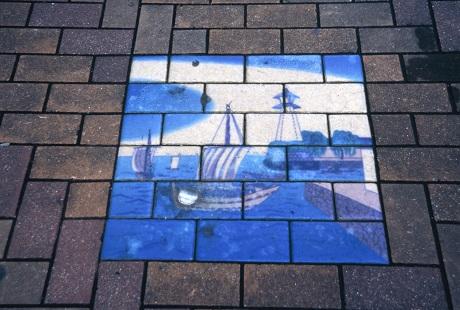
Photo courtesy of Chuo Ward Kyobashi Library
A Benzai ship floating on the blue waves. It seems to have brought goods from a distant place. In the background, you can also see the lighthouse of Ishikawajima. It is also depicted that the waterway is broken to Tsukuda moat. At present, Sumiyoshi sluice gate is built there.

Photo courtesy of Chuo Ward Kyobashi Library
This is like a Bensai ship that also carried goods. Important products are covered with rain like Toma so that they do not get wet with rain or waves. Over there you can see the roof of Sumiyoshi-jinja Shirine. All of them look like the scenery of the Edo period. Minato-ko, who found this photo, was impressed. And thank Mr. Hirai for taking the picture.
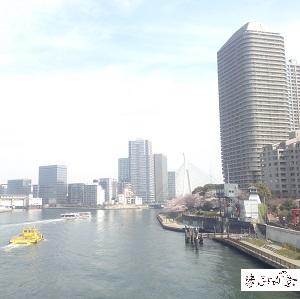 At the mouth of the Sumida River, surrounded by Tsukuda Island and Eitai Bridge, many boats were anchored, and the surrounding towns were crowded with Setori-juku and wholesalers who served cargo. This is the center of Edo Minato. At the mouth of the Sumida River, surrounded by Tsukuda Island and Eitai Bridge, many boats were anchored, and the surrounding towns were crowded with Setori-juku and wholesalers who served cargo. This is the center of Edo Minato.
In Edo, there were no port facilities where large boats could land directly. This is due to the terrain of the Sumida River, because the flowing sand accumulated at the bottom of the river and created shallow waters.
For this reason, large vessels that have sailed from various countries have anchored off the mouth of the Sumida River, which is `` Edo Minato '', or off the coast of Shinagawa, transshipped goods into a small boat called Setori Ship (tea ship), It was carried to the storehouse of a wholesaler lined up on the banks of the river. (On the right, you can see the ruins of the current Ishikawajima Lighthouse, Tsukuda Island, and Sumiyoshi Suimon. Chuo-ohashi Bridge and Shinkawa buildings on the 1994 bridge in front. )
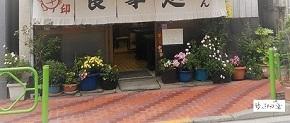 Another thing, "Usako Tsukuda", who was with me on the radio the other day, gave me special information. There is a picture of Indian spot-billed duck on this "Tsukuda Nakadori"! That's right. It was Minato kid who went out with breath, but unfortunately the pavement was newer. Indian spot-billed duck's paintings are not left in the Kyobashi Library. What kind of Indian spot-billed duck was?...I disappointedly dropped my shoulders, but I still enjoy walking just by thinking that there was a picture of Indian spot-billed duck here. Thank you, Mr. Usako Tsukuda. Another thing, "Usako Tsukuda", who was with me on the radio the other day, gave me special information. There is a picture of Indian spot-billed duck on this "Tsukuda Nakadori"! That's right. It was Minato kid who went out with breath, but unfortunately the pavement was newer. Indian spot-billed duck's paintings are not left in the Kyobashi Library. What kind of Indian spot-billed duck was?...I disappointedly dropped my shoulders, but I still enjoy walking just by thinking that there was a picture of Indian spot-billed duck here. Thank you, Mr. Usako Tsukuda.
The city of Tokyo doesn't stop. That's why I think it's important. At least, I want to remember my favorite scenery and place.
※For posting photos, we apply to the Chuo Ward Kyobashi Library and obtain permission.
Chuo-ku Tourism correspondent Minatokko-chan

No. 14 May 24, 2018
[Minato kid]
May 28, 2018 14:00
A lot of flowers are planted on the promenade of the Sumida River Terrace. These flowers are taken care of by local town councils and volunteers. The Tokyo Metropolitan Park Association calls this activity "Hanamori-san" and supports it in providing seedlings and technical training.
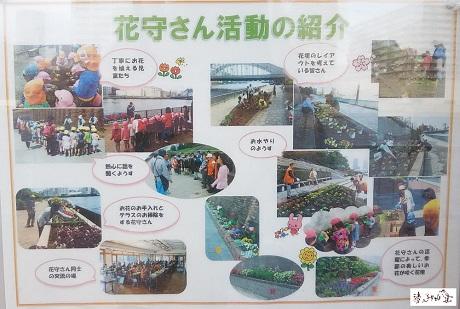
♪ From the "Waterside Terrace Information Bulletin Board" installed on Sumida River Terrace
Today, I would like to walk about 800m promenade up to Minato, Akashicho and Tsukiji 7-chome. Pass through Tsukuda-ohashi Bridge, look up at St. Luke's Tower, and cross the Tokyo Mizube Line (starting and landing in front of Akashicho and St. Luke's Garden), wave your hand on a pleasure boat going through the Sumida River, and eventually meet Kachidokibashi. Here, cute flowers from five groups welcomed passers-by.
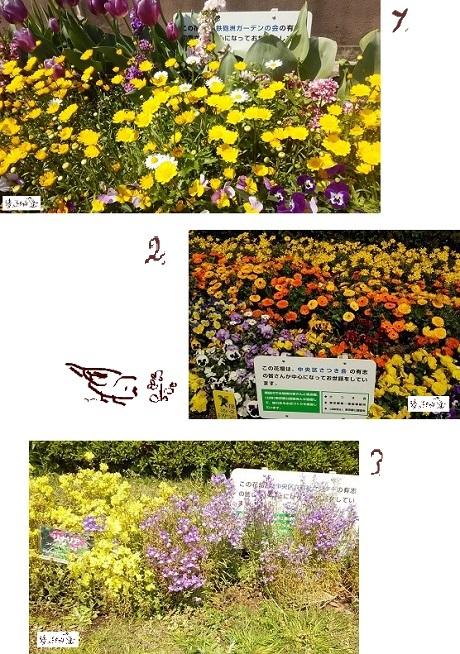
♪Members of the Gunpow Garden Association (1)
♪Members of the Chuo-ku Satsuki-kai (2)
♪Everyone at Chuo Ward Welfare Center (3)
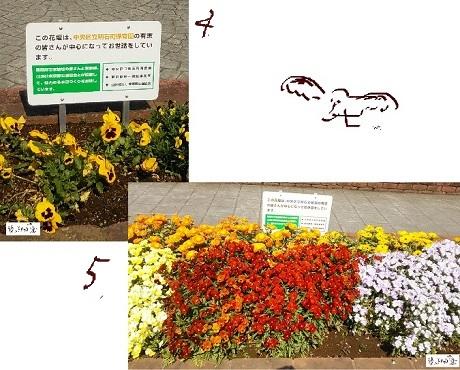
♪Everyone at Tatemei Kokumachi Nursery School in Chuo-ku (4)
♪Everyone at Akashi Kindergarten, Chuo-ku (5)
From the cold days when the cherry blossoms had not yet bloomed, the flowers of Hanamori-san were coloring the terrace. In early spring, tulips are at their best, and now it is time to replant. The flowers are beautifully arranged at any time. I'm sure you visit the flowers every day and take care of them. I think it's hard to take care of you, but I'm grateful to Mr. Hanamori.
♪ What kind of flowers will you meet next time, I'm looking forward to it!
Chuo-ku Tourism correspondent Minatokko-chan

No. 13 May 23, 2018
[Minato kid]
May 27, 2018 12:00
On the downstream side of Akatsuki Bridge in Tsukiji River Park (in the direction of Honganji), there was a time when large-scale sewerage works were being performed. When the soundproof wall was removed, I found something stoney in the grass. If you look closely, it is written as "Sakaihashi".
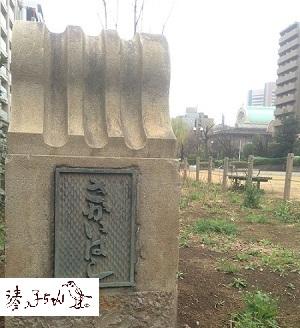
Since I started studying the Chuo-ku Tourism Certification, I learned that Sakae Bridge was a bridge between Akashibori and Tsukiji River. If you look more closely, it is regarded as a "bridge that does not exist" in the material of Hobo. Why is it like this?...I can't do it.
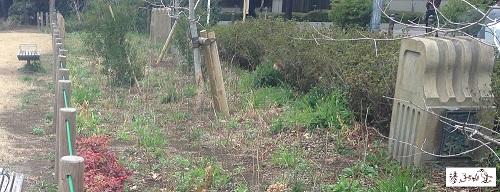 ▲There were two main pillars: "Sakaihashi" and "Sakae Bridge" (foreground). ▲There were two main pillars: "Sakaihashi" and "Sakae Bridge" (foreground).
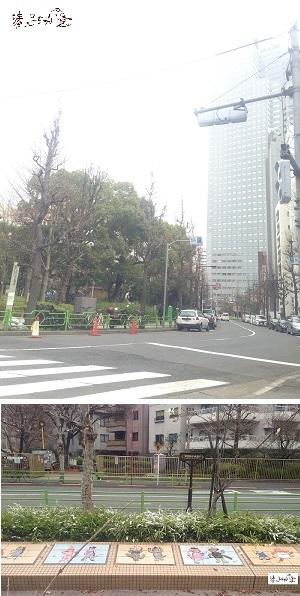 In Akashibori, the current Akatsuki Park area is the former one. It was shaped like a triangle, with "Shinminato Bridge" at the entrance to the Tepposu River and "Sakae Bridge" at the entrance from the Tsukiji River. In Akashibori, the current Akatsuki Park area is the former one. It was shaped like a triangle, with "Shinminato Bridge" at the entrance to the Tepposu River and "Sakae Bridge" at the entrance from the Tsukiji River.
In the middle of the triangle, the settlement Chuo-dori crosses between the Adventure Square, but just around that, the Shin-ei Bridge, which was called the entrance to the foreign settlement, would have been built.
Akashibori has been used as a boat pool since the Edo period. After the great fire of the Meiryaku era, fishermen from Banshu Akashi emigrated and looked like Tsukuda Island on the opposite bank as Awaji Island. Akashibori was reclaimed in 1970 (1930), and then the Tsukiji River began reclaiming in the 1940s, and there seems to be some places that remained until 1995.
(Upper) The entrance to the Tepposu River, Shinminato Bridge, where the entrance to Akatsuki Park / (bottom) Shin-ei Bridge, which is currently located in the middle of Akashibori, is currently "Residential Chuo-dori "
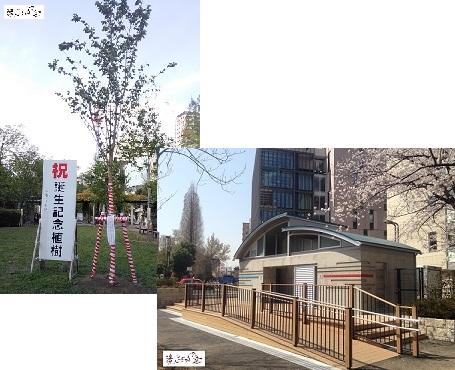
In addition, there is a public toilet on the upstream side of Akatsuki Bridge (St. Luke's area), which has been renewed this year. Barrier-free. And a new birth memorial tree was also planted.
It is a rapidly changing city in Tokyo, but I would like you to gently leave the main pillar of Sakae Bridge here in this place. Or I think it's better if the nameplate is attached. In any case, I want the passers-by to be cherished.
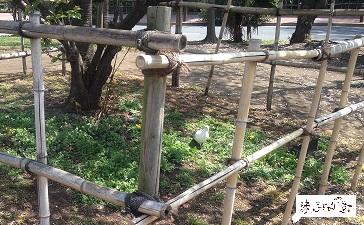
▲A white pigeon that came to Tsukiji River Park
Chuo-ku Tourism correspondent Minatokko-chan

No. 12 May 22, 2018
[Minato kid]
May 25, 2018 14:00
In Chuo-ku, there are 98 routes that are familiar to the local community and have nicknames. There are stories on every path, and they tell us with various expressions. And in fact, roads without nicknames are packed with many charms. Today, I would like to spotlight on such a casual road.
♪ A retro road under high speed
This is the road ahead of Ginza 1-17, "Kibikicho Nakadori" begins. I don't have a nickname. If you dare to say it, Special Metropolitan Route 451. There is a Ginza 1-chome parking lot at the Metropolitan Expressway, and next to it is the Kyobashi fire department. It is a quiet road just one from Showa-dori, but there are many cars and traffic, making it an indispensable road for daily life.
The Kyobashi River is an approximately 600m waterway excavated from outer moat to Kaede River during the Keicho era of the Edo period. As part of the post-war reconstruction project, landfill began in 1954 (1954), and disappeared in 1959 (1959). There must have been a white fish bridge around here. Now the highway crosses overhead to create a shade.

This Ginza 1-chome parking lot is entirely bricked. It has a somewhat nostalgic atmosphere. There is a resident, and there is a place where eyes meet unintentionally through a large window, and there is something humanity. There is a small planting beside the sidewalk, and flowers are blooming. Surrounded by the noise of concrete and cars, the small flowers convey the season well.

The next Kyobashi fire truck has a different address and will be Kyobashi 3-chome 14. If you look into the gap between the Ginza 1-chome parking lot, the other side of the street has a steeply subducted terrain, and you can see cars going through the former Kaede River at a high speed. There were cute flowers in the planting of the entrance. And Kuta-kun is posing. In addition, there is also a mini curve mirror for Cuta, which is cute.
♪ Automatic telephone exchange launch site
On the other side of the Ginza 1-chome parking lot is already Kibikicho Nakadori. I meet a big building in Seiko Watch. When I turned around the corner and turned toward Shinkinbashi, I found a monument to "Automatic Telephone Exchange Shonochi" in the planting on the premises. There is this in the monument.
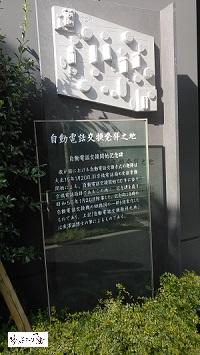 ― The automatic telephone exchange system in Japan originated on January 20, 1926, when the exchange service of the former Kyobashi telephone office began. In the 50th anniversary of the start of automatic telephone exchange, a monument was built in this area, the site of the Kyobashi telephone station, and unveiled on January 20, 1975. The monument is a stylized part of the circuit diagram of the automatic telephone exchange machine at that time, and the "automatic telephone exchange launch site" is written by Dr. Shigeru Yonezawa.― ― The automatic telephone exchange system in Japan originated on January 20, 1926, when the exchange service of the former Kyobashi telephone office began. In the 50th anniversary of the start of automatic telephone exchange, a monument was built in this area, the site of the Kyobashi telephone station, and unveiled on January 20, 1975. The monument is a stylized part of the circuit diagram of the automatic telephone exchange machine at that time, and the "automatic telephone exchange launch site" is written by Dr. Shigeru Yonezawa.―
(1-26-1 Ginza, Chuo-ku, Tokyo)
In 1975 (1975), when this monument was unveiled, the building called Hotel Ginza Laffinate (formerly Kyobashi Kaikan) was built here. At that time, I saw a larger schematic on the outer wall of the entrance. The Seiko Watch building was built in May 2016 (May 2016). I think this monument was also newly rebuilt in line with it. Right now, the NTT East Kyobashi Building is located in Ginza 2-chome. If you look at it in this way, there is an irreplaceable "Ayumi" on the unnamed road. That's why the sidewalk in Chuo-ku is interesting! I think so.
Chuo-ku Tourism correspondent Minatokko-chan

No. 11 May 20, 2018
[Minato kid]
May 23, 2018 18:00
Koji Ogawa was born in Minatomachi, Chuo-ku (currently Minato) in 1948 (1948). From 1976 (1976), he began sketching in Chuo-ku with the desire to keep the old cityscape. Ogawa's gaze is not only famous buildings, but also in casual alleys and street corners.
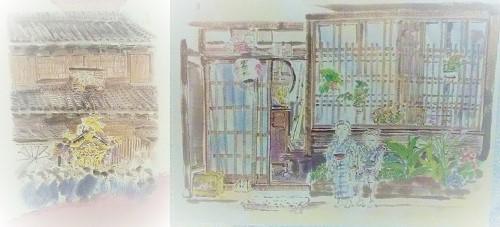
― I was born and raised in Minato, a gunshot in Chuo-ku, Tokyo. The birthplace was a "Shimotaya" with a lattice bay window. "Ogawa's neighborhood has a lot of interesting houses." When I was told by a classmate at Geidai, I realized that it was a unique and harmonious cityscape with a copper-covered store, a pushshibushi tenement shop, a girder shop, a relief and colorful tiled house. I reconfirmed that, but I was born and raised in that, thought it was natural. (Same as below from the special exhibition booklet)―
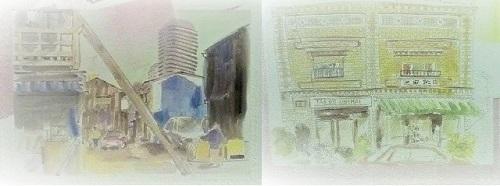 ― In 1976, with the rebuilding of my old home, I went from the neighboring houses to Nihonbashi and Ginza, and started drawing a city of memories. Occasionally, land prices have risen in Tokyo, and the streets that grew up with my grandfather, father and me for three generations have been raised one after another under redevelopment, and the familiar scenery and moist daily life since childhood have disappeared. I have done it. At that time, I began to feel a strong sense of crisis and a sense of mission.― ― In 1976, with the rebuilding of my old home, I went from the neighboring houses to Nihonbashi and Ginza, and started drawing a city of memories. Occasionally, land prices have risen in Tokyo, and the streets that grew up with my grandfather, father and me for three generations have been raised one after another under redevelopment, and the familiar scenery and moist daily life since childhood have disappeared. I have done it. At that time, I began to feel a strong sense of crisis and a sense of mission.―
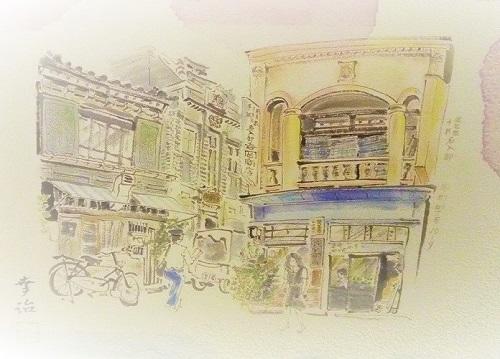
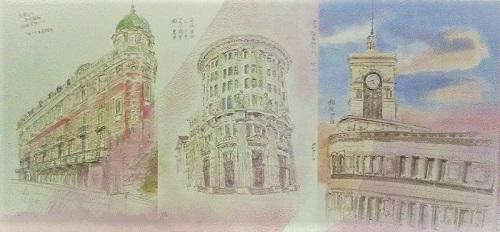
― The bustle of Ginza, the fish shore of Tsukiji, modern downtown, alley planting, and long-established Nihonbashi. The historical city has its own taste. When I heard about the rebuilding of Theatre Tokyo, Niski, Tokyo Stock Exchange, etc., I went there early and started sketching.―
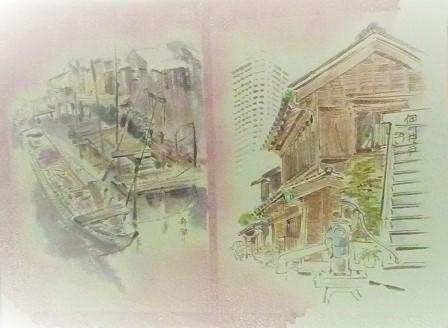
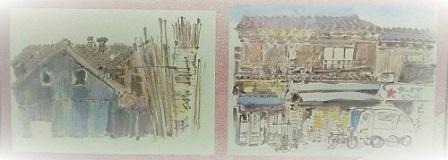
― The three major changes in the city of Tokyo were the Great Kanto Earthquake, World War II, and the rising whirlwind. The city of Tokyo is too wide and has a lot of problems and is very interesting.―

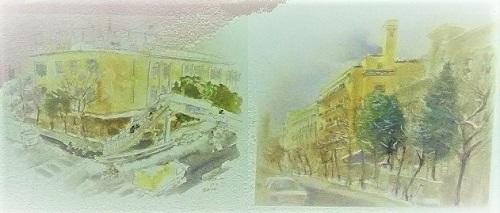
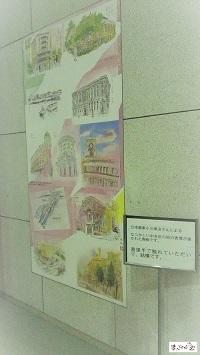 Koji Ogawa's words included in the booklet of "Ginza, Tsukuda, Nihonbashi at the end of the 20th century special exhibition Koji Ogawa's Tokyo painting" held in October 2007 at Time Dome Akashi, Chuo Ward Local Tenmonkan. At the end of the 20th century, from Showa to Heisei, it was a time when Tokyo changed drastically. And in the 21st century, Tokyo continues to carve a new time. Koji Ogawa's words included in the booklet of "Ginza, Tsukuda, Nihonbashi at the end of the 20th century special exhibition Koji Ogawa's Tokyo painting" held in October 2007 at Time Dome Akashi, Chuo Ward Local Tenmonkan. At the end of the 20th century, from Showa to Heisei, it was a time when Tokyo changed drastically. And in the 21st century, Tokyo continues to carve a new time.
Ogawa's work can be seen in the free space at the entrance on the first floor of the building of Rainbow House Akashi. It is printed directly on a stone wall and tells us about the good old streets. (I took a picture of the work here.)
Chuo-ku Tourism correspondent Minatokko-chan

No. 10 May 19, 2018
[Minato kid]
May 22, 2018 09:00
There are a lot of nice sidewalks in Chuo-ku. Above all, the sidewalk with pictures showing the characteristics of the town is charming and very interesting. I would like to introduce you to such a unique sidewalk.
♪ Welcome to the sidewalk museum!

This is the sidewalk at the base of Miyoshibashi in front of Chuo-ku government office. The picture of Miyoshi Bridge is drawn. In the picture, there are several trees in the distance. I think this is a scenery overlooking Miyoshi Bridge from the ward office. It is also the scenery of the time when the river was still flowing. Looking at the photos of 1930, the same outdoor light and protective fence were shown as those currently standing on Miyoshi Bridge. At that time, the ward office building also had a rounded retro atmosphere.

This is the sidewalk with a picture of Miyoshi Bridge toward Ginza. The street address is drawn. But was there any construction of the sidewalk that was missing? I feel the pride of the local people in "My town" in drawing the town name as a character instead of a picture.
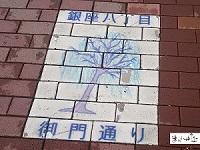
It's "Mimon-dori" at 8-chome in Ginza. It was the place where Shibakuchi Gomon was built in 1710. It is Kitazume in Shimbashi, which now runs over the former Shiodome River, where the highway runs. Nearby, there was also a figure of Yanagi Shisei in Ginza.
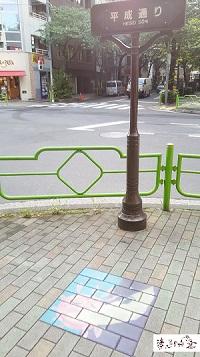 This is a picture I found on the sidewalk of Heisei-dori. The moon and the sun. I also checked the nearby sidewalk, but this was the only place where there was a picture. Who painted this pretty cute picture? There is Sakamoto Elementary School nearby, so it may be a student's work. This is a picture I found on the sidewalk of Heisei-dori. The moon and the sun. I also checked the nearby sidewalk, but this was the only place where there was a picture. Who painted this pretty cute picture? There is Sakamoto Elementary School nearby, so it may be a student's work.
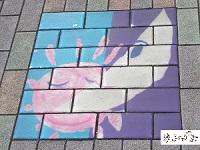

Well, I found such a small manhole. The flower azalea of the ward and the tree and eel of the ward are drawn. And the word "light". This seems to contain the wiring of streetlights. I was impressed by the vivid colors and the pictures and letters lined up in a small circle. Minato kid found this manhole under Takahashi over the Kamejima River, Minato 1-chome side, and then Akashicho. In addition, there seems to be a different color, so I would like to look for it.
♪ There seems to be still a nice sidewalk.
Chuo-ku Tourism correspondent Minatokko-chan

No. 9 May 18, 2018
|
Links
|


 Suddenly, I found a white tile with faded color. I'm sure the picture was drawn. Since this is Tsukuda, I wonder if it was a picture related to Tsukuda Island?...I wanted to meet this path sooner...Minato-ko thought of it.
Suddenly, I found a white tile with faded color. I'm sure the picture was drawn. Since this is Tsukuda, I wonder if it was a picture related to Tsukuda Island?...I wanted to meet this path sooner...Minato-ko thought of it.

 At the mouth of the Sumida River, surrounded by Tsukuda Island and Eitai Bridge, many boats were anchored, and the surrounding towns were crowded with Setori-juku and wholesalers who served cargo. This is the center of Edo Minato.
At the mouth of the Sumida River, surrounded by Tsukuda Island and Eitai Bridge, many boats were anchored, and the surrounding towns were crowded with Setori-juku and wholesalers who served cargo. This is the center of Edo Minato. Another thing, "Usako Tsukuda", who was with me on the radio the other day, gave me special information. There is a picture of Indian spot-billed duck on this "Tsukuda Nakadori"! That's right. It was Minato kid who went out with breath, but unfortunately the pavement was newer. Indian spot-billed duck's paintings are not left in the Kyobashi Library. What kind of Indian spot-billed duck was?...I disappointedly dropped my shoulders, but I still enjoy walking just by thinking that there was a picture of Indian spot-billed duck here. Thank you, Mr. Usako Tsukuda.
Another thing, "Usako Tsukuda", who was with me on the radio the other day, gave me special information. There is a picture of Indian spot-billed duck on this "Tsukuda Nakadori"! That's right. It was Minato kid who went out with breath, but unfortunately the pavement was newer. Indian spot-billed duck's paintings are not left in the Kyobashi Library. What kind of Indian spot-billed duck was?...I disappointedly dropped my shoulders, but I still enjoy walking just by thinking that there was a picture of Indian spot-billed duck here. Thank you, Mr. Usako Tsukuda.





 In Akashibori, the current Akatsuki Park area is the former one. It was shaped like a triangle, with "Shinminato Bridge" at the entrance to the Tepposu River and "Sakae Bridge" at the entrance from the Tsukiji River.
In Akashibori, the current Akatsuki Park area is the former one. It was shaped like a triangle, with "Shinminato Bridge" at the entrance to the Tepposu River and "Sakae Bridge" at the entrance from the Tsukiji River.




 ― The automatic telephone exchange system in Japan originated on January 20, 1926, when the exchange service of the former Kyobashi telephone office began. In the 50th anniversary of the start of automatic telephone exchange, a monument was built in this area, the site of the Kyobashi telephone station, and unveiled on January 20, 1975. The monument is a stylized part of the circuit diagram of the automatic telephone exchange machine at that time, and the "automatic telephone exchange launch site" is written by Dr. Shigeru Yonezawa.―
― The automatic telephone exchange system in Japan originated on January 20, 1926, when the exchange service of the former Kyobashi telephone office began. In the 50th anniversary of the start of automatic telephone exchange, a monument was built in this area, the site of the Kyobashi telephone station, and unveiled on January 20, 1975. The monument is a stylized part of the circuit diagram of the automatic telephone exchange machine at that time, and the "automatic telephone exchange launch site" is written by Dr. Shigeru Yonezawa.―

 ― In 1976, with the rebuilding of my old home, I went from the neighboring houses to Nihonbashi and Ginza, and started drawing a city of memories. Occasionally, land prices have risen in Tokyo, and the streets that grew up with my grandfather, father and me for three generations have been raised one after another under redevelopment, and the familiar scenery and moist daily life since childhood have disappeared. I have done it. At that time, I began to feel a strong sense of crisis and a sense of mission.―
― In 1976, with the rebuilding of my old home, I went from the neighboring houses to Nihonbashi and Ginza, and started drawing a city of memories. Occasionally, land prices have risen in Tokyo, and the streets that grew up with my grandfather, father and me for three generations have been raised one after another under redevelopment, and the familiar scenery and moist daily life since childhood have disappeared. I have done it. At that time, I began to feel a strong sense of crisis and a sense of mission.―









 This is a picture I found on the sidewalk of Heisei-dori. The moon and the sun. I also checked the nearby sidewalk, but this was the only place where there was a picture. Who painted this pretty cute picture? There is Sakamoto Elementary School nearby, so it may be a student's work.
This is a picture I found on the sidewalk of Heisei-dori. The moon and the sun. I also checked the nearby sidewalk, but this was the only place where there was a picture. Who painted this pretty cute picture? There is Sakamoto Elementary School nearby, so it may be a student's work.


